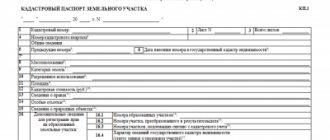Home / Real estate / Land / Land survey / Cadastral passport
Back
Published: 03/02/2017
Reading time: 8 min
0
397
When registering ownership rights to a land plot (LZ) or transactions with it, certain documents are required regarding information about the characteristics of such a plot.
- Documentation
- Cadastral plan
- Cadastral passport
- Differences between KP and KPL
- Extract from the Unified State Register of Real Estate instead of a cadastral passport
Cadastral passport
| Description: | Until the beginning of 2020, this was the main cadastral registration document, which confirmed the availability of data on real estate (building, land) in the State Property Committee. At the moment, its legal force is negligible. |
| What is it needed for: | Now this is just another unnecessary piece of paper, which will still be stored “just in case” in a pile of real estate documents. |
| Where to get it: | Not issued. |
| When appeared: | In March 2008, along with the appearance of the boundary plan. The basis for the appearance of a cadastral passport is Federal Law No. 221 “On the State Real Estate Cadastre” (in general, in cadastral relations, this law is currently the main one). Until this time, the main cadastral document was the cadastral plan of the land plot (buildings were indicated there as parts of the land plot). |
| Best before date: | Essentially it is indefinite. But now you can’t put it anywhere. |
| Link to other documents: | The cadastral passport included a cadastral plan; this was its integral graphic component. |
For each property, the cadastral passport had its own established form. This document included the main technical characteristics of the property.
Technical passport
| Description: | It is often confused with cadastral. Both are passports. Only their legal and actual purpose are very different. Technical passports began to be issued earlier than cadastral passports. Until 2013, it was the technical passport that was the basis for entering data about property into the State Real Estate Cadastre and registering real estate. Now the cadastral passport has been abolished, and the technical passport serves as a “secondary document” for rather narrow purposes. It is no longer used for real estate registration. A technical passport is prepared only for real estate (structures, buildings, premises), and its purpose is a detailed accounting of technical characteristics and an indication of the inventory value. |
| What is it needed for: | - when transferring real estate from residential to non-residential - to obtain permission for redevelopment or reconstruction of real estate - during legal proceedings -for internal needs of management companies -for assessment and pledge of property |
| Where to get it: | The preparation of this document is carried out exclusively by the BTI. Despite the fact that, by law, BTI ceased to be a monopolist in the preparation of documents for registration of buildings and premises, it retained the technical inventory. |
| When appeared: | In the form that it has now, it appeared on October 1, 1997. Minor changes in form do not change the overall essence. |
| Best before date: | Has no expiration date. Again, even if a deadline is written on it, this is the arbitrariness of the BTI. For transactions, there is a 1-year rule behind the scenes - to update, just get a fresh one from the district BTI. It is necessary to order a new one only if redevelopment has been carried out. |
| Link to other documents: | On its basis, data was entered into the real estate cadastre until January 1, 2013, and the owner was issued a cadastral passport. A technical passport produced before January 1, 2013 can serve as the basis for preparing a technical plan. Passports issued after this date are not used to register real estate in the cadastral register. |
Based on the information from this document, taxes and utilities are calculated, decisions are made on major and current repairs of apartment buildings, construction and reconstruction, permits are issued for redevelopment and reconstruction of residential premises, as well as for the supply of communications during construction and after, constructed houses are registered, etc. .P.
Unlike the technical plan, the technical passport focuses on the technical characteristics of the object. For example, if we are talking about an apartment, then there will be data such as the year the house was built and last overhauled, the number of floors in the house and rooms in the apartment, ceiling heights, wall and ceiling materials, the presence of water supply and sewerage, type of heating, etc. . There will also be an inventory value (some abstract value). It should not be confused with the cadastral document, according to which tax is calculated.
Technical plan
| Description: | A technical plan is a document required when registering new objects for state cadastral registration or changing information about existing unfinished construction objects, premises, buildings and structures. In other words - OKS (capital construction projects). This document differs from a technical passport in the mandatory presence of exact coordinates of all characteristic points that indicate the contour and location of the property. Such as buildings/structures on a plot of land or premises within a building. Such data can only be obtained during geodetic measurement work. |
| What is it needed for: | - to put the facility into operation - for registration/removal of real estate from cadastral registration -to make changes to the real estate register after reconstruction/redevelopment - during legal proceedings |
| Where to get it: | this document is prepared by cadastral engineers |
| When appeared: | from January 1, 2012. Replaces a technical passport when registering real estate for state cadastral registration |
| Best before date: | In fact, it has no expiration date. But this is an interim document. The purpose of its preparation is to enter information into the State Property Committee and register the property. If a technical plan was prepared for you and for some reason was not submitted to Rosreestr, you should not delay it. After all, legislation doesn’t go unnoticed - and within a month your technical plan may not meet the new requirements. It is necessary to prepare a new one only if the property has been redeveloped, reconstructed or destroyed. |
| Link to other documents: | After submitting the technical plan to Rosreestr, you will receive an extract from the Unified State Register of Real Estate about the OKS facility. The technical passport can be used to prepare a technical plan. |
As a result, any data on capital construction projects is entered into cadastral registration using a technical plan.
There will be more cadastral passports and Unified State Register extracts
From 01/01/2020, all information about real estate objects and registered rights to these objects are entered into the Unified State Register of Real Estate. The Unified State Register of Real Estate has combined the State Property Committee and the Unified State Register of Real Estate, thus all information about real estate objects and registered rights is now contained only in it.
Calculator
We remind you that as of July 15, 2020, the issuance of certificates of state registration of property rights has ceased. Until January 31, 2020, ownership of the property was confirmed by a record of rights in the Unified State Register of Real Estate. From January 1, 2020, ownership of a property is confirmed by a record of such right in the Unified State Register of Real Estate. An extract (public information) from the unified state real estate register about real estate objects and registered rights to them can be ordered both electronically and in paper form.
- registration number, address and purpose of the object;
- main characteristics: area, floor, plan, cadastral value;
- Full name of the copyright holder (copyright holders) and the share of each owner;
- encumbrances on the object (if any).
We recommend reading: Child feeding benefits in the Voronezh region documents
Cadastral plan
| Description: | Cadastral plan—a graphical representation of real estate objects (buildings, plots) and detailed technical information about these objects is reflected in the cadastral plan of a plot of land. It is part of the cadastral passport. Without a cadastral plan, a cadastral passport is considered incomplete. But this is the case if the boundaries of the land plot are established in accordance with land legislation. If not installed, the cadastral plan will not be in the passport. Now it is no longer issued. |
| What is it needed for: | It won't be useful anymore. |
| Where to get it: | Nowhere. You can only find it in your old land documents. |
| When appeared: | In March 2008, along with the appearance of the boundary plan. The basis for the appearance of the cadastral plan is Federal Law No. 221 “On the State Real Estate Cadastre”. |
| Best before date: | Has no expiration date. |
| Link to other documents: | The cadastral plan is included in the cadastral passport and is an integral part of it. In connection with the abolition of the cadastral passport, the cadastral plan became part of the extract from the Unified State Register of Real Estate. Now it is called “Description of the location of the land plot”, section 3. |
Very often, lawyers, realtors and notaries use the expression “cadastral plan”, meaning slightly different documents. Most often we are talking about an Extract from the Unified State Register of Real Estate. This is the main document certifying your property in the cadastral register. It is also worth mentioning that there is such a document as a cadastral plan of the territory. This is a slightly different document, which is also issued by the cadastral chamber. More details at the link above.
When the cadastral passport for real estate was canceled
/ / 04/16/2018 206 Views And do not forget that not a single state body or local government body has the right to demand the provision of any extracts from the state information systems of other bodies. According to Federal Law dated July 27, 2010 No. 210-FZ
“On the organization of the provision of state and municipal services”
, persons wishing to receive a state or municipal service can provide information held by other authorities and administrations of settlements and districts only on their own initiative. The fee for issuing information from the Unified State Register is not a state duty, and the procedure for paying the fee is not regulated by the Tax Code.
Therefore, the fee can be paid by any person both before and after submitting a request for an extract from the Unified State Register. Please note that state registration of rights to a land plot, information about which has been canceled from the State Property Committee, cannot be carried out. Article 20 of the Federal Law of July 21, 1997 No. 122-FZ
“On state registration of rights to real estate and transactions with it”
It has been determined that state registration of the right to a real estate property is not allowed if this property is not considered registered in accordance with the Federal Law “On the State Real Estate Cadastre”.
Taking into account the above-mentioned norms of current legislation, we recommend that all owners of land plots promptly register ownership (lease) of their land plots.
Info Also, the technical plan may contain information about part or parts of capital construction projects, or new information necessary for inclusion in the Unified State Register of Real Estate. It is prepared by a cadastral engineer based on the design documentation or declaration submitted by the customer for cadastral work.
The services of a cadastral engineer are paid.
It is worth noting that from 1
Cadastral extract (extract from the Unified State Register of Real Estate)
| Description: | It’s not for nothing that in the title we combined the cadastral extract and from the Unified State Register of Real Estate. These are practically identical documents. Only in the extract from the Unified State Register of Real Estate data on rights was added. Cadastral extract - an extract from the state real estate cadastre. In its appearance and purpose it is very similar to a cadastral passport. Yes, and they have few differences. The main thing is the presence in the extract of the coordinates of the turning points of the land plot. For the owner, these coordinates are useless; they can only be used by a surveyor-cadastral engineer, for example, to locate a plot of land. Important: cadastral extracts are no longer issued. Only an extract from the Unified State Register. Therefore, below the abbreviation “extract” is equivalent to an extract from the Unified State Register of Real Estate. |
| What is it for: | An extract is needed wherever it is necessary to prove the presence of an object in the cadastral register. -when making real estate transactions, donations, wills, etc. - when redeveloping real estate or changing the boundaries of a land plot, it is necessary to update the extract - during legal proceedings -when the address of the object changes |
| Where to get it: | Cadastral data, and an extract is no exception, can currently be obtained in 3 ways: at the cadastral chamber branch closest to the property, the MFC, and electronically on the Rosreestr website. A document received by any of the listed options has the same legal force. However, it is not always convenient to provide the electronic form to different authorities, since electronic document management is not yet used everywhere. Important - if the object is not registered in Rosreestr, you will not receive an extract. If it was previously registered, but subsequently deregistered, this data will be indicated in the statement. |
| When appeared: | In March 2008, along with the appearance of the boundary plan, a cadastral extract appeared. Extract from the USRN from January 1, 2020. The basis for the appearance of a cadastral extract is Federal Law No. 221 “On the State Real Estate Cadastre”. Its editors also “gave birth” to an extract from the Unified State Register of Real Estate. |
| Best before date: | Has no expiration date. It is necessary to order a new one only if a technical or boundary plan is submitted for redevelopment of real estate or changing the boundaries of the site. Also, when making any transaction, a fresh statement will be required to certify that the object has not undergone any changes (up to 2 weeks). |
| Link to other documents: | Based on the technical and boundary plan, changes are made to the cadastral data, which are then displayed in the extract. |
Cadastral passport: why was it canceled and what document replaced it?
The cadastral passport in the form in which it was issued until 2017 was an extract from the State Property Committee, the state real estate cadastre, about the property. Anyone could order it, including non-citizens of the Russian Federation. Documents in paper and electronic form included different information: Paper.
Consisted of two sections. KP.1 - with general information about the apartment (address, area, unique cadastral number, cadastral value, purpose, etc.) and KP.2 - with a drawing plan and sometimes a diagram of the location of the object on the floor. In 10% of cases, the document contained only section KP.1.
Electronic. In 90% of cases, the passport had only section KP.1 - without drawing plans.
For identification with the responsible authorities, an electronic digital signature of the Rosreestr registrar was provided along with it, in contrast to the paper version with a blue seal and hand-painted. The abolition of the cadastral passport was the logical conclusion of the reorganization of the document flow system.
The previously existing Unified State Register of Real Estate and the State Register of Real Estate merged into a single structure - the Unified State Register of Real Estate.
In this regard, the issuance of Certificates of state registration of property rights was first canceled, and the title-establishing characteristics were transferred to the extract from the Unified State Register of Real Estate (section No. 2).
Since 2020, the need for a cadastral passport has also disappeared, since information from it, including the cadastral plan, also began to be displayed in the USRN extract. The introduction of the Federal Law No. 218 also pursued goals other than simplifying document flow. Previously, the procedure for registering property rights was complex, lengthy and opaque due to numerous bureaucratic obstacles.
I had to collect the same package of documents twice and wait about a month each time.
This created the ground for the emergence of fraudulent schemes in transactions with apartments, houses, and land plots. After the abolition of the procedure, the risks of falling for scammers have decreased significantly.
The merger of the Unified State Register and State Tax Committee was aimed at eliminating errors in duplicating information and simplifying the procedure.
Now









